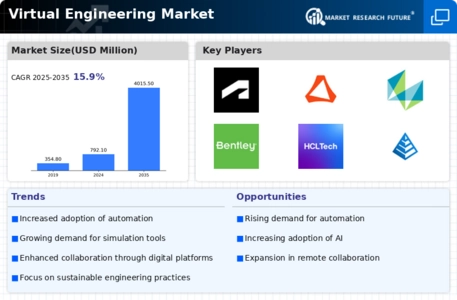Market Share
Virtual Engineering Market Share Analysis
The Virtual Engineering market, characterized by its dynamic and rapidly evolving nature, relies heavily on effective market share positioning strategies to stay competitive. Companies operating in this space employ various tactics to carve out a niche and capture a substantial portion of the market. One prevalent approach is differentiation, wherein companies seek to distinguish their virtual engineering solutions from competitors by offering unique features, cutting-edge technologies, or specialized services. This not only attracts customers looking for specific capabilities but also helps build brand loyalty.
The other important strategy is cost leadership and where companies will endeavour to optimise their operational efficiencies where they deliver virtual engineering solutions at below the cost of the rivals. This procedure does not have any restrictions on the markets it is suitable for, provided that there is sensitivity to prices as such companies can reach a larger group of independent consumers and convince them. The perfect balance between costing and quality remains one of the main challenges in the virtual engineering market as a competitively priced product still needs to ensure high quality and be innovative.
The market share positioning as well as the innovation role is relatively crucial in Virtual Engineering. Businesses make every effort to distinguish themselves from the competition by being progressive in their technological ventures and finding new applications that others are yet to discover even while improving existing ones to meet present industry needs such as those in the field of manufacturing, automotive, and aerospace. The firms that adopt emerging technologies such as VR and AR early tend to wind up receiving a competitive advantage in the market, which attracts customers who desire novel solutions.
More and more, such cooperation and strategic alliances are evolving in the sector parallely increasing market share positioning in Virtual Engineering space. For the case of virtual engineering, companies tend to align themselves with other organizations like software developers, hardware manufacturers and industry experts that will help them come up with solutions that are solutions that are thorough in nature and well integrated. By drawing from this partners’s strengths, firms are able to provide richer solutions that address customer needs beyond entity borders or service scope.
Major elements of the market share strategies in focus is reliant on proper marketing and positioning of brands that are identified with virtual engineering. Businesses spend their enormous amounts of money forming a perfect brand image staling with their special skills and trustability along with client satisfaction. Honing marketing messages tailored to their customers and building a strong online presence are instrumental in distinguishing these companies within this competitive market while increasing consumers’ interest in what they have to offer.
In addition, if a firm is to position itself in terms of market share successfully understanding and meeting the unique needs of a given industry become very necessary. Companies in the Virtual Engineering market customise their solutions for models tailored to match the specific needs of verticals such as healthcare, architecture and energy. This strategy is focused on industries; via this approach, companies obtain niche markets easier takes positions of leaders in some spheres. Customer support and service excellence contribute significantly to market share positioning strategies in the virtual engineering sector. Offering robust customer support, training programs, and continuous engagement fosters long-term relationships with clients. Satisfied customers are more likely to become loyal advocates, promoting a positive reputation and attracting new business through word-of-mouth referrals.

















Leave a Comment